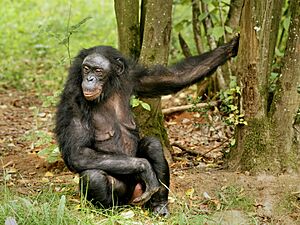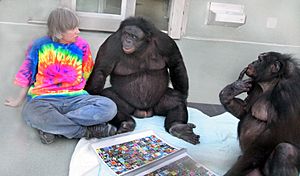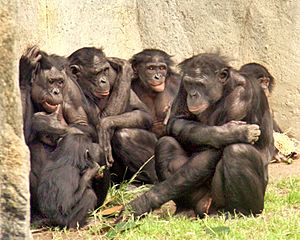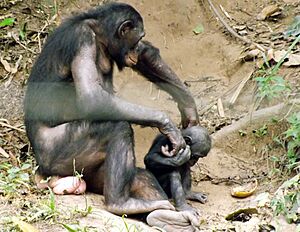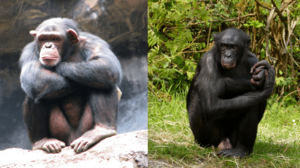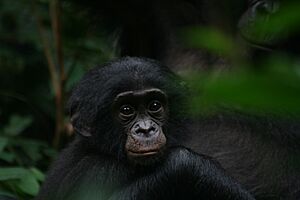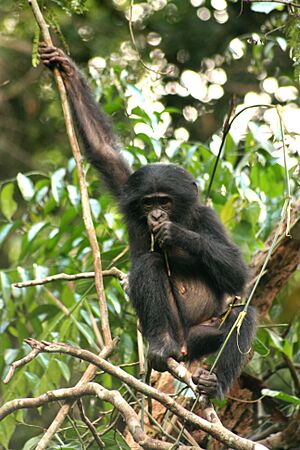Bonobo facts for kids
The bonobo (Pan paniscus), sometimes called the pygmy chimpanzee, is an endangered great ape. It is one of two species in the Pan group, the other being the common chimpanzee. Bonobos are very close relatives to humans.
Bonobos look similar to common chimpanzees. However, bonobos have longer limbs, pinker lips, and a darker face. They also have a small tail-tuft and longer hair on their heads. Bonobos live in the Congo Basin in the Democratic Republic of the Congo (DRC), Central Africa. They mostly eat fruit, but also other plants and small animals. They live in both old and new forests, including swampy areas. Because of challenges in the region, it has been hard for scientists to study bonobos in their natural home.
The Congo River separates bonobos from common chimpanzees. Bonobos live south of the river. Scientists believe the river helped these two ape species become distinct about 1.5 to 2 million years ago. There are an estimated 29,500 to 50,000 bonobos left. They are threatened by losing their homes and by hunting. Bonobos can live up to 40 years in zoos. Their lifespan in the wild is not fully known.
Quick facts for kids Bonobo |
|
|---|---|
 |
|
| Male at Apenheul Primate Park | |
| Conservation status | |
| Scientific classification | |
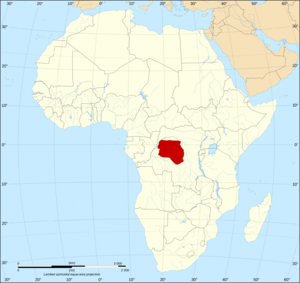 |
|
| Bonobo distribution |
Contents
What's in a Name?
The bonobo was once called the "pygmy chimpanzee." This name was given in 1929 by a German zoologist named Ernst Schwarz. He thought they were smaller than common chimpanzees. However, bonobos are actually about the same size.
The name "bonobo" first appeared in 1954. It might have come from a misspelled name on a shipping box. The box was from a town called Bolobo on the Congo River. This is where the first bonobo specimens were found.
Bonobo Family Tree
The bonobo was first recognized as a unique animal in 1928. A German scientist, Ernst Schwarz, noticed differences in a bonobo skull. In 1933, another scientist, Harold Coolidge, officially made it a separate species.
Bonobos and common chimpanzees are the only two species in the Pan group. They are our closest living relatives, along with humans (Homo sapiens). Scientists use DNA to study how animals are related. DNA evidence shows that bonobos and chimpanzees became separate species about 890,000 to 860,000 years ago. The Congo River likely played a big role in keeping these two groups apart.
Bonobo Genetics
Scientists have studied the bonobo's genome, which is like its genetic instruction book. The first full bonobo genome was published in 2012. A better quality one became available in 2021. This research helps us understand how bonobos are related to humans and other apes. It shows that bonobos and chimpanzees are very similar genetically.
Bonobo Hybrids
Sometimes, bonobos and chimpanzees can have babies together in zoos. This is rare in the wild because the Congo River keeps them apart. Scientists have studied these hybrid offspring to learn more about both species.
What Bonobos Look Like
Bonobos are often described as more slender than common chimpanzees. While large male chimpanzees can be heavier, bonobos and chimpanzees are generally similar in size. Adult female bonobos are a bit smaller than males. Males usually weigh about 45 kg (99 lb), and females about 33 kg (73 lb).
Bonobos are about 70 to 83 cm (28 to 33 inches) long when on all fours. When standing upright, males average 119 cm (3.9 ft) tall, and females 111 cm (3.6 ft). Their heads are smaller than chimpanzees' with less noticeable brow ridges. They have black faces with pink lips, small ears, and wide nostrils. They also have long hair on their heads that often has a parting.
Bonobos spend time both on the ground and in trees. On the ground, they usually walk on all fours, using their knuckles. They can also walk on two legs, just like humans, though they do this less often in the wild. Their body shape and posture make them look more like humans than common chimpanzees do. Each bonobo also has unique facial features, which helps them recognize each other in their social groups.
Bonobo Behaviour and Social Life
Scientists like Frans de Waal say bonobos are capable of kindness, empathy, and patience. They are known for their peaceful nature. Bonobo society is often described as a "matriarchy" or female-led society.
Social Structure
Bonobos have a unique social structure where females often lead the group. They don't have strict territories and travel widely to find food. Female bonobos form strong friendships and alliances with each other. These alliances help them have influence over males. While a single male might be stronger, a group of females can work together to make decisions.
At the top of a bonobo group is often an experienced female leader. She helps make decisions for the group. High-ranking females protect new females joining the group. Some males can also achieve high rank, often with the help of their mothers. These males might help coordinate group movements and warn of dangers.
Male bonobos get their social status from their mothers. The bond between a mother and her son stays strong throughout their lives. Bonobos are generally tolerant of infants and young bonobos. Different bonobo groups often interact peacefully and even share food. In November 2023, scientists even reported seeing different bonobo groups cooperating with each other. They shared food and groomed each other.
Social Bonding and Conflict Resolution
Bonobos use various forms of physical contact and interaction to greet each other, form strong friendships, and resolve disagreements peacefully. This helps keep their groups calm and connected. Females often engage in mutual physical contact to strengthen their bonds. These strong female bonds allow them to choose their mates and prevent aggressive males from forcing interactions.
When bonobos find a new food source, they often engage in social interactions. This helps reduce tension and encourages peaceful sharing of food.
Reproduction and Life Cycle
Wild female bonobos usually have their first baby around 13 or 14 years old. They carry and nurse their young for about four years. On average, they give birth every 4.6 years.
Unlike some other apes, bonobos are not known to kill their infants in the wild. This might be because female bonobos mate with many males. If males are unsure which offspring are theirs, they are less likely to harm any infant. This strategy helps protect the young.
Peaceful Nature and Aggression
Bonobos are generally more peaceful than common chimpanzees. Chimpanzee males are known to be hostile to outsiders. Bonobos, however, seem to prefer social contact over violent fights with other groups.
While bonobos are peaceful, they are not entirely without aggression. Males can sometimes fight each other, leading to injuries. Females also show aggression, especially when defending food or their allies. However, lethal aggression is very rare among bonobos. In April 2024, biologists reported that bonobos can behave more aggressively than previously thought.
Scientists have found differences in bonobo brains compared to chimpanzees. Bonobos have more grey matter in areas linked to empathy, sensing distress, and controlling impulses. This might explain why they are better at regulating their emotions and behavior.
What Bonobos Eat
Bonobos are omnivorous, meaning they eat both plants and animals. About 57% of their diet is fruit. They also eat leaves, honey, eggs, and small animals like monkeys, duikers (small antelopes), and insects. They have even been seen hunting monkeys.
Bonobo Intelligence
Bonobos are very intelligent. They can recognize themselves in a mirror, showing self-awareness. They communicate using sounds and facial expressions. Scientists have learned that bonobos use the same call for different things, and other bonobos understand the meaning based on the situation. In February 2025, scientists found that bonobos could tell when humans did not know something.
Two famous bonobos, Kanzi and Panbanisha, learned to communicate using a special keyboard with symbols. Kanzi learned over 500 English words and understood about 3,000 spoken English words. Kanzi even learned to make and use simple stone tools by watching humans. This shows how smart and observant bonobos can be.
Bonobos also show empathy. They will comfort others who have been hurt or are upset. They even laugh when tickled, much like human babies!
Where Bonobos Live
Bonobos are found only south of the Congo River and north of the Kasai River. These rivers are in the Democratic Republic of Congo. They live in the humid forests of this region. The Congo River acts as a natural boundary, separating bonobos from chimpanzees.
Bonobos' Role in Nature
In the Congo rainforest, many plants need animals to help them reproduce and spread their seeds. Bonobos are the second largest fruit-eating animals in this area, after elephants. It is estimated that each bonobo will eat and spread about nine tons of seeds in its lifetime. These seeds come from over 91 different plant species.
Bonobos carry seeds in their digestive system for about 24 hours. This means they can drop the seeds several kilometers away from the parent plant in their droppings. These seeds can then grow into new plants. This process is very important for the health of the rainforest. Without bonobos, many plant species would struggle to spread and grow.
Protecting Bonobos
The IUCN Red List lists bonobos as an endangered species. Their population is estimated to be between 29,500 and 50,000 individuals. The biggest threats to bonobos are habitat loss (losing their forest homes) and hunting for bushmeat. Hunting increased a lot during the wars in the Democratic Republic of Congo.
Conservation efforts need the help of local communities. Some local people have been against creating national parks because they were forced to leave their homes in the past. However, there are places where bonobos thrive because local beliefs protect them.
Many groups are working to save bonobos. The Bonobo Conservation Initiative started the Bonobo Peace Forest Project in 2002. This project works with local communities to create protected areas managed by the people who live there. This model helps protect over 50,000 square kilometers (19,000 sq mi) of bonobo habitat.
The Zoological Society of Milwaukee (ZSM) also works to protect bonobos. They conduct surveys, develop anti-poaching measures, and provide training and education for Congolese people. They have built schools, hired teachers, and started agriculture projects. These efforts help local communities and give them a reason to protect the bonobos.
The U.S. government has also invested in the Congo Basin Forest Partnership. This helps international groups work on bonobo conservation. Despite these efforts, the bonobo population has declined sharply in the last 30 years. Organizations like the World Wide Fund for Nature and the African Wildlife Foundation are raising awareness about the urgent need to protect these amazing apes.
Bonobos in Human Culture
World Bonobo Day is celebrated every year on February 14, which is Valentine's Day. It was established in 2017 by the African Wildlife Foundation to raise awareness about bonobos.
See also
 In Spanish: Bonobo para niños
In Spanish: Bonobo para niños
- Basankusu, DR Congo – base for bonobo research and conservation
- Bonobo Conservation Initiative
- Chimpanzee genome project
- Claudine André
- Great ape personhood
- Great Ape Project
- International Primate Day
- Kanzi
- List of apes – notable individual nonhuman apes
- Lola ya Bonobo
- Koba, a fictional bonobo and antagonist of the Planet of the Apes reboot series



